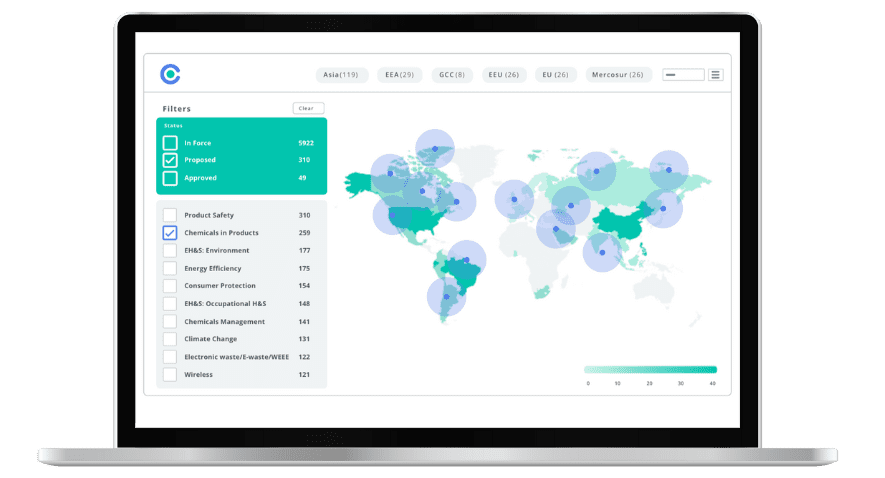
Washington State Publishes Draft Regulatory Determinations for PFAS in Apparel

This blog was originally posted on 9th January, 2024. Further regulatory developments may have occurred after publication. To keep up-to-date with the latest compliance news, sign up to our newsletter.
AUTHORED BY MARIA MARECKI, MARKET ACCESS MANAGER, COMPLIANCE & RISKS
The State of Washington Department of Ecology has published draft regulatory determinations for restrictions and reporting requirements for apparel and gear under the Safer Products for Washington program.
The Safer Products for Washington program implements the Toxic Pollution Law. The law authorizes Ecology to regulate classes of chemicals in consumer products.
Cycle 1.5 of the Safer Products for Washington program focuses on making regulatory determinations on several products identified in the 2021 PFAS Chemical Action Plan (CAP), which includes apparel and gear.
Ecology is required to make an initial set of regulatory determinations on these products by June 2024 and adopt rules by December 2025.
In December 2023, Ecology published Draft Regulatory Determinations Report to the Legislature: Safer Products for Washington Cycle 1.5 Implementation Phase.
Per the Toxic Pollution Law, one the following regulatory determinations for each chemical-product combination in the report may be made:
- Determine that no regulatory action is currently required;
- Require a manufacturer to provide notice of the use of a priority chemical or class of priority chemicals;
- Restrict or prohibit the manufacture, wholesale, distribution, sale, retail sale, use, or any combination thereof, of a priority chemical or class of priority chemicals in a consumer product.
In order to to restrict priority chemicals Ecology must confirm:
- Safer alternatives are feasible and available;
- The restriction will either reduce a significant source or use of a priority chemical or is necessary to protect the health of sensitive populations or sensitive species.
When safer alternatives to PFAS are identified, restrictions are proposed. When safer alternatives are not identified, reporting requirements are proposed.
Regarding applicability, apparel is defined as, “clothing, including outerwear meant to cover the body.”
This includes apparel and gear marketed for general consumer use, as well as extended-use products intended for use by experts or professionals and not available to the general public.
The Report gives the following examples of apparel and gear:
- Apparel includes athleticwear, reusable diapers, menstrual underwear, rainwear, school uniforms, dresses, hats, scarves, gloves, and shoes;
- Gear includes non-clothing items that are used for a particular purpose, such as backpacks, sleeping bags, umbrellas, camping furniture, and climbing rope;
- Extended-use products are defined as outdoor apparel designed for outdoor sports experts. Extended-use products provide protection against extended exposure to extreme rain conditions or against extended immersion in water or wet conditions, including snow, to protect the health and safety of the user. These products are not marketed for general consumer use. Examples of extreme and extended-use products include outerwear for offshore fishing, offshore sailing, whitewater kayaking, and mountaineering.
RCW 70A.350.0103 defines PFAS as a class of fluorinated organic chemicals containing at least one fully fluorinated carbon atom.
The Report makes the following draft regulatory determinations:
- Reporting requirement for apparel intended for extended use by experts or professionals that are not marketed to the general public;
- Reporting requirement for shoes;
- Restriction for all other types of apparel; and
- Reporting requirement for gear.
In examining alternatives, Ecology was not able to identify any safer chemical alternatives to PFAS for use in apparel and gear.
Three alternative materials and two alternative processes considered to be safer, feasible, and available were identified. While alternatives for apparel were identified, examples of these alternatives were not identified for use in professional apparel designed for outdoor sports experts. It is also noted the use of the alternatives for use in footwear is limited.
The report discusses altered weaves, laminated textiles, cleaning methods, and wearing protective garments to prevent stains on apparel as alternatives.
Public comment on the report closes on January 22, 2024. Comments are made using the Public Comment Form.
Stay Ahead Of Regulatory Changes
Accelerate your ability to achieve, maintain & expand market access for all products in global markets with C2P – Your key to unlocking market access, trusted by more than 300 of the world’s leading brands.
C2P is an enterprise SaaS platform providing everything you need in one place to achieve your business objectives by proving compliance in over 195 countries.
C2P is purpose-built to be tailored to your specific needs with comprehensive capabilities that enable enterprise-wide management of regulations, standards, requirements and evidence.
Add-on packages help accelerate market access through use-case-specific solutions, global regulatory content, a global team of subject matter experts and professional services.
- Accelerate time-to-market for products
- Reduce non-compliance risks that impact your ability to meet business goals and cause reputational damage
- Enable business continuity by digitizing your compliance process and building corporate memory
- Improve efficiency and enable your team to focus on business critical initiatives rather than manual tasks
- Save time with access to Compliance & Risks’ extensive Knowledge Partner network

Simplify Your Product Compliance Process with C2P
Design & build new products with full confidence you’ve met all compliance obligations


